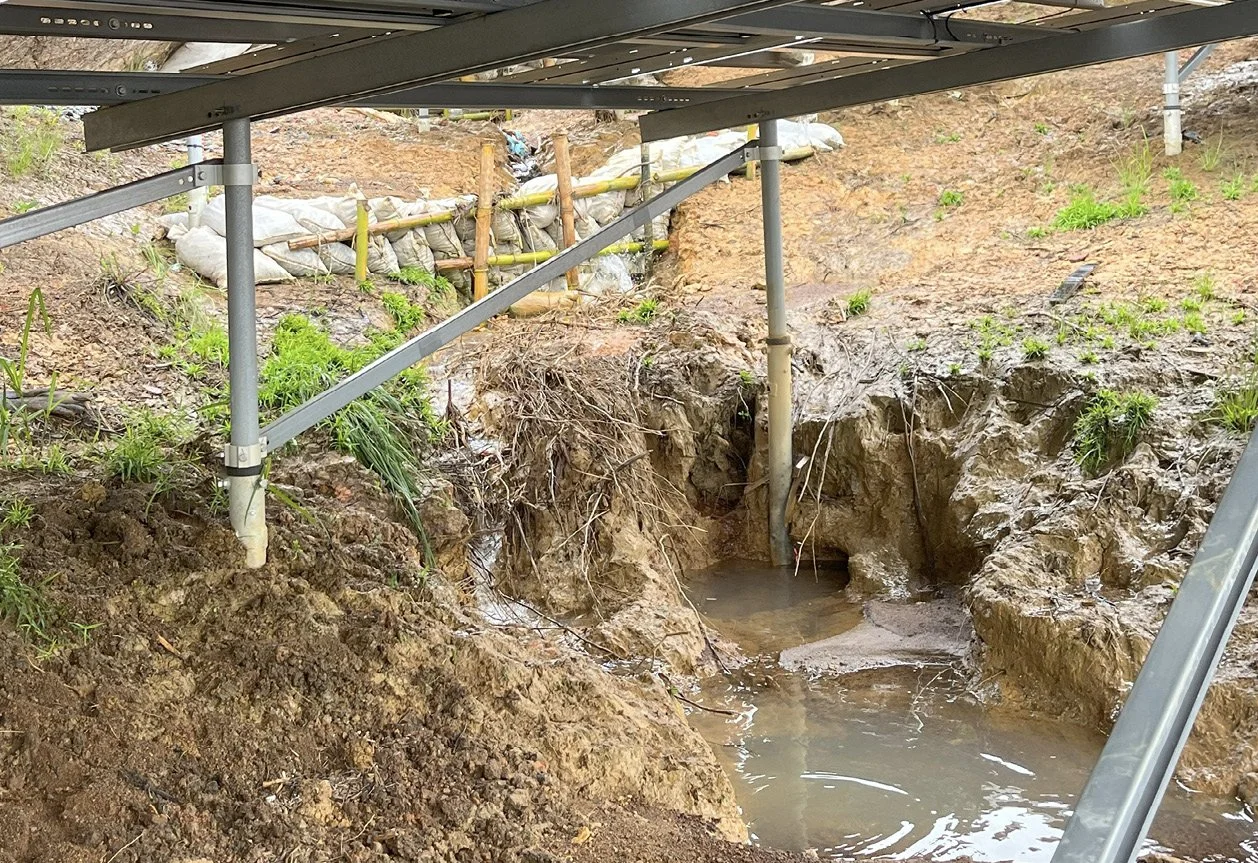Floodplains and Fault Lines
by Nicholas Hudson and Evan Woolard
This article was originally published in pv magazine - July & August 2025 Edition.
With the early expiration of key US solar tax credits in 2026 and 2027, solar developers from the United States and Europe are looking to diversify, and the Asia-Pacific (APAC) region represents attractive prospects for many. But unpredictable site conditions can defy even the most experienced developers’ assumptions, causing delays and cost hikes. Upfront due diligence is vital, argue Clean Energy Associates engineers Nicholas Hudson and Evan Woolard.
Heavy rainfall can cause erosion around foundation piles due to poor drainage and site preparation
The US solar industry has thrived on an abundance of flat, dry land, where minimal civil work was needed. But in Southeast Asia, land is limited and often uneven. Developers are routinely forced to choose between expensive grading or proceeding as things are and accepting lower energy production per hectare.
Without a deep understanding of these challenges, even well-funded projects can be delayed, derailed, or ultimately fail to deliver their expected value.
Areas near volcanoes are particularly challenging. One site we supported in Southeast Asia had highly unstable, fragmented soil with poor load-bearing capacity. The developer’s original plan relied on driven piles, but the lack of consistent granular soils couldn’t support them. Concrete ballast blocks were added, but heavy rainfall and improper drainage led to erosion around the foundations. Some structures were damaged beyond repair and had to be rebuilt.
The cheapest land is often cheap for a reason. If you aren’t factoring civil constraints into your project selection and design, you’re taking on unnecessary risk.
Soil conditions
Poor soil quality isn’t just an inconvenience – it’s a major source of delays and cost increases. Driven piles may be the most economical foundation solution, but only if the soil can support them. In regions with high clay content, piles may shift or “jack” over time due to seasonal expansion and contraction. In Japan, earthquakes can cause ground liquefaction, where the soil temporarily behaves like a liquid and can no longer support the structures above it.
On the other end of the spectrum, some sites contain rocks or boulders that make pile driving prohibitively expensive. In those cases, every foundation must be predrilled, an option that may not be available in the region.
CEA often sees developers plan their market entry strategy based on land price and access to the grid. Soil rarely enters the conversation, but a single bad decision can force a costly redesign later on.
Flash floods
The climatic conditions in some APAC countries can be another major differentiator. Intense rainfall, for example, is common in Malaysia, Indonesia, and the Philippines. Temporary roads can wash out, bridges can collapse from scouring, and exposed soil can erode more quickly than expected.
The land itself can be a dynamic factor in APAC. Many site survey findings, such as ground water, stream paths, vegetation thickness, or even the elevation of the land itself may be significantly different from one year to the next. What’s often underestimated is the ripple effect of poor site preparation – especially when drainage systems, temporary roads, or bridges aren’t properly designed or reinforced. If these early access structures fail, it doesn’t just delay a portion of the work, it can make the entire site inaccessible.
Fixed assumptions
Trackers are increasingly common in US and Australian utility-scale projects, but they’re far less common in Southeast Asia, and for good reason. Heavy rainfall and frequent cloud cover reduce the energy gains from trackers. Complex terrain introduces shading risks and makes it difficult to keep the rows of solar panels aligned. In many cases, the added costs of foundation depth and structural reinforcement don’t justify the modest production boost.
Some developers in Asia are exploring terrain-following trackers, and leading equipment providers are developing smarter control systems that can optimize energy yield in cloudy conditions. In the future, these innovations may open the door to wider adoption. Today, most developers still find fixed-tilt systems to be the more practical choice.
“The land itself is a dynamic factor in
the Asia-Pacific region”
Wind loading
In high-wind regions, especially those subject to oceanic typhoons such as Taiwan and the Philippines, overturning and uplift forces must be carefully considered – especially when systems are elevated above ground level.
Some developers raise solar modules to allow agricultural use underneath or to reduce the risk of flooding. But greater elevation means more wind exposure, which requires deeper foundations and stronger racking systems.
The risk isn’t just limited to design. If your site is surrounded by water or exposed to typhoons, logistics can also be affected. In these areas, it’s vital to revisit your assumptions about material transport, installation schedules, and equipment handling.
Many of the problems seen by CEA could have been avoided with earlier and more detailed engineering studies. But in the rush to secure land and grid connections, site risks are often overlooked until it’s too late.
By the time technical teams are brought in, critical decisions – such as foundation type, layout, and scheduling – may already be locked in, even if they don’t match the reality on the ground. In contrast, when engineering work is done early, before selecting the site, potential issues can be flagged that won’t show up on satellite maps or spreadsheets.
While upfront due diligence may seem like an added cost, it often prevents far more expensive problems later on.
Evan Woolard is Associate Director of Engineering Services at Clean Energy Associates. Based in Singapore, Woolard has more than 15 years of experience in the Asia-Pacific region and 20 years in energy. He helps clients with technical due diligence, risk management, and engineering and construction challenges.
Nicholas Hudson is Principal Engineer at Clean Energy Associates, bringing deep experience in structural engineering, site assessment, and solar asset due diligence. Based in Austin, Texas, he leads analysis on site conditions, permitting, and construction risk for utility-scale projects.











